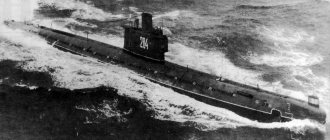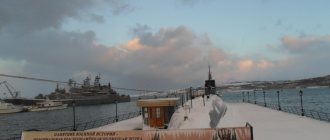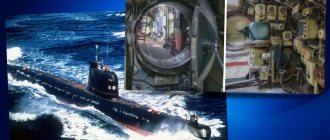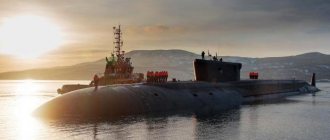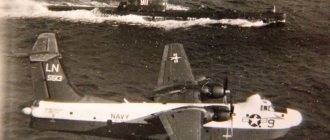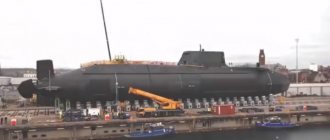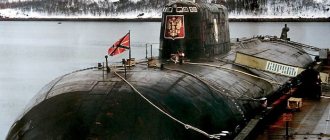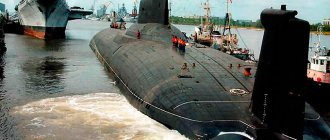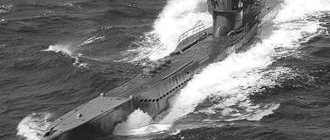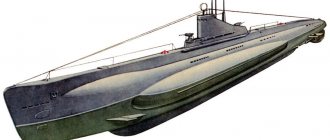“Kazan” is the sister of “Severodvinsk”
This boat is the “little sister” of the Severodvinsk nuclear submarine from the Yasen project. The latter went through 17 years of design and construction before launching in 2010. But the Kazan 855 submarine was born in just eight years. And the age difference is significant - such hydroacoustics and low noise were never dreamed of by the older sister. The Kazan nuclear submarine is a hybrid of the Project 971 Gepard-class underwater hunter and the Project 949A Kursk-class cruise missile submarine, truly multi-purpose and very dangerous.
History of the creation of the Project 885 Yasen nuclear submarine
Multi-purpose nuclear submarine Yasen, the technical characteristics of which are designed to be equipped with cruise missiles on board - nuclear submarine project 885M (08851) , an improved version of the lead submarine of the Yasen nuclear submarine project (according to NATO codification - "Graney", "Yasen").
See also the article Nuclear submarine Komsomolets and its characteristics
The nuclear submarine 885M is an improved version of the Yasen nuclear submarine project.
According to the strategic plans of the leadership of the Armed Forces of the Russian Federation until 2020, 7 units should be included in the Navy. Yasen-class submarines (project 885) should gradually replace multi-purpose boats of earlier projects. The first nuclear submarine of Project 885 (K560 Severodvinsk) was built according to the original design. The remaining boats are being built according to Project 885M.
The history of the project dates back to 1977. The military leadership of the USSR developed the concept of replacing a large number of different types of multi-purpose diesel and nuclear submarines of the second and third generations with an improved fourth generation boat.
The multi-purpose submarine was supposed to perform various strategic and tactical missions anywhere in the World Ocean. Russia's new Yasen submarines were supposed to be an adequate response to the development by the US military-industrial complex in the last quarter of the twentieth century of the latest multi-purpose submarines of the Seawolf and Virginia classes.
1977 — The Leningrad Closed Submarine Fleet Design Bureau (the future St. Petersburg Marine Engineering Bureau “Malachite”) receives the task of designing a fourth-generation multi-purpose nuclear submarine with a minimum noise level, armed with cruise missiles and torpedoes.
1988 — in the specialized magazine “Gangut” published in Leningrad, a photograph, information about the parameters, a description of the performance characteristics and features of the fourth generation submarine, designed under the code 885 “Ash”, appears for the first time. The author of the article is Deputy Chief Designer of the Malachite MBM A.M. Antonov.
1993 — the first boat of Project 885 was laid down. She received the code K-560 and the name of the nuclear submarine Project 885 Yasen “Severodvinsk”.
1996 — work on building the boat has been stopped indefinitely due to lack of funding.
2004 — construction of the lead boat of Project 885 has been resumed.
2009 — the second boat of the project was laid down. It was decided to carry out construction according to the modernized project 08851 “Yasen-M”. The ship received the code K-561 and the name “Kazan”.
24.06.2010 — the multipurpose nuclear submarine “Severodvinsk” was launched.
Taking the boat K-560 out of the boathouse to
26.07.2013 — the third nuclear submarine of the Yasen-M project, K-573 Novosibirsk, was laid down.
12.09.2011 — start of mooring tests of K-560. The refinement of the main parameters and a set of factory tests continued for three years.
05.11.2013 - start of state tests of the Severodvinsk SSGN.
30.12.2013 — the state commission signed an act of acceptance of the boat.
17.06.2014 — the K-560 submarine was enlisted in the Russian Navy.
27.07.2014 — the fourth nuclear submarine "Krasnoyarsk" of project 885 Yasen - K-571 was laid down.
19.03.2015 — the fifth Yasen-class nuclear submarine, K-564 Arkhangelsk, was laid down.
29.07.2016 — the sixth boat of the project (“Perm”) was laid down.
31.03.2017 — the boat K561 “Kazan” was solemnly launched.
28.07.2017 — the seventh boat of the project, named “Ulyanovsk,” was laid down.
See also the article Project 956 “Sarych” and its development history
A series of seven boats of Project 08851 “Yasen-M” should be fully operational in the Russian Navy by 2023.
Chief designer of project 885 “Ash” V.N. Pyalov
"Kazan" - history
Since 1977, in the Soviet Union, three design bureaus have been working on the creation of fourth-generation submarines with the following corporate colors: red “Ruby” (St. Petersburg), green “Malachite” (St. Petersburg) and blue “Lapis Lazuli” ( Gorky). The first specialized in boats with anti-ship weapons, the second developed multi-purpose boats, and the third worked on an anti-submarine system. But submarines were becoming more and more expensive for the state, so it was decided to combine the efforts of all bureaus in the “Malachite” Yasen project. The base submarine of the K-560 project is Severodvinsk. And the submarine “Kazan” K-561 is the first in the modernized project 855 “Yasen-M”. There are plans for five more boats - Novosibirsk, Krasnoyarsk, Arkhangelsk, Perm and Ulyanovsk.
The Invisible Threat
And this is only the most general data; the exact characteristics of the nuclear-powered ships of the Yasen project are kept strictly secret. However, these ships, as the American analytical publication The National Interest writes, made an indelible impression on the command of NATO naval forces. American Rear Admiral Dave Johnson even installed a model of a Russian submarine in his office, saying that US Navy officers must understand what they will be dealing with in the event of a conflict with Russia. How the Kuznetsov disgraced the Russian fleet
Russia's closest neighbors were the first to sound the alarm. The head of the intelligence service of the Norwegian Ministry of Defense, Morten Hagi Lunde, said that the Norwegian military is having difficulty detecting Russian Navy submarines. “The modern equipment of Russian submarines is at such a level that it is becoming increasingly difficult to detect them,” Lunde said. According to him, the latest submarines can move underwater almost silently.
The CNN television channel, citing US Navy experts, reported that the new Russian submarines of the Yasen project are challenging the dominance of the American submarine fleet. “We are back in the days when we must consider the presence of an enemy capable of challenging us underwater. There is no longer guaranteed superiority,” complained US Navy Captain Oliver Lewis.
American experts are concerned about Russia's plans to launch a new type of submarines into the sea that will be able to hunt US submarines armed with ballistic missiles. “The US Navy is not entirely confident that it can track them. Among all the submarines that US rivals have, the Yasen submarines are the quietest,” said Michael Kofman, an analyst at the Washington Wilson Center.
Multi-purpose submarines of the Seawolf and Virginia classes are considered American analogues of the Yasen. Russian and foreign experts more often compare Yasen with Seawolf, without giving a clear preference to one of the boats. The noiselessness of the Yasen is expected to be comparable to its American counterparts, but the Yasen is designed for a wider range of tasks.
The National Interest magazine expert Kyle Mizokami, having compared the tactical and technical characteristics of Russian and American fourth-generation multipurpose nuclear submarines, came to the conclusion that in the event of a “duel” between them, the American submarine has a greater chance of winning due to more advanced electronics.
However, the advantage of American submarines is not obvious. The military editor of The National Interest, Dave Majumdar, has the opposite opinion. According to his calculations, in a one-on-one duel, “Yasen” has a better chance of winning. He notes that fortunately for American sailors, the Russian Navy has only one Project 885 ship (Severodvinsk) in service, while the US Navy has 12 Virginias and three Seawolves.
Photo: press service of SPMBM “Malachite”
The director of the American Institute for the Study of Russia's Maritime Potential, Michael Peterson, has a strong opinion on this matter. “The Yasen nuclear submarines are the most dangerous weapons the Russian Navy has,” he said.
Characteristics of the submarine "Kazan"
| Ship type | SSGN |
| Project | "Ash" 855 |
| Surface speed | 16 knots |
| Underwater speed | 31 knots |
| Autonomous swimming | 100 days |
| Crew | 64 people |
| Power point | Pressurized water reactor OK-650V |
| Immersion depth | |
| Working | 520 meters |
| Maximum | 600 meters |
| Submarine dimensions | |
| Length | 139.2 meters |
| Width | 13 meters |
| Medium draft | 9.4 meters |
| Displacement | |
| Surface | 8.6 tons |
| underwater | 13.8 tons |
| Armament | |
| Torpedo-mine | Ten 533 mm torpedo tubes, USET-80 torpedoes |
| Rocket | 8/4 launchers "Onyx" and "Caliber" |
Design solutions
Unlike submarines of the third generation, boats of the fourth have not a double-hull, but a one-and-a-half-hull design. The light hull covers only part of the Kazan submarine - the bow and superstructures of the missile silos. The body and propeller with seven sickle-shaped blades are made of low-magnetic steel. In the bow there is a spherical antenna of the Amphora hydroacoustic station of the new generation Irtysh complex. Due to this placement, torpedo tubes were removed from the bow.
Missile "Ash"
Boats of the Yasen-M project will be responsible for combating aircraft-carrying groups of a potential enemy, monitoring enemy submarines with nuclear weapons, and also striking strategically important ground targets.
Projects 885 and 885M use a mixed design system, where the lightweight hull “envelops” only part of the strong one in the bow to reduce noise. It is made of high-strength low-magnetic steel. This allows the Kazan to dive to a depth of more than 600 m, which makes it practically inaccessible to all types of modern anti-submarine weapons. Conventional nuclear submarines dive to 400 m.
Eight vertical launchers and TA are used for firing. The submarine's arsenal includes the most modern Russian Kalibr cruise missiles and Oniks anti-ship missiles.
The firing range of the former is more than 1.5 thousand km, which allows such boats to keep an eye on areas remote from the sea or ocean coast. “Onyxes” are designed to combat surface naval groups and single ships in conditions of strong fire and electronic countermeasures, as well as for attacks on ground targets.
boat
Photo: TASS/Alexander Ryumin
In the future, the boat will be able to use hypersonic Zircons. They can accelerate to Mach 8 and hit targets at a range of up to 500 km. A speed of Mach 2.5 is the maximum speed for modern air defense systems, which will allow missiles to overcome any defense. The boat can also carry anti-submarine torpedoes, which will be needed to destroy enemy submarines.
The nuclear submarine reactor is manufactured using new technology: the primary coolant pipelines are located inside its body. This arrangement is considered innovative, as it significantly reduces the likelihood of accidents and radiation exposure of the crew. Without recharging, the reactor can operate for 25–30 years, which is comparable to the service life of the submarine itself. This will greatly simplify its operation.
Western analysts often compare the Yasen in terms of combat capabilities with American Sea Wolf-class submarines. Only three of them were built; for financial reasons, they decided to abandon the project. The Sea Wolves turned out to be the most expensive submarines ever built for the US Navy.
Power point
The Kazan submarine is equipped with a water-nuclear reactor with an integrated circuit layout and primary circuit pipelines located in the reactor vessel. This design significantly reduces the likelihood of accidents and emergency situations. The information and control system constantly monitors the radiation level. In addition, it significantly reduces noise levels, even at speeds of 25 knots. The service life is comparable to the service life of a submarine and is 30 years. In order to reduce noise, all components and assemblies of the submarine are equipped with noise suppression systems. And at low speeds, the boat has the ability to run on electric motors, which also makes it inconspicuous on enemy radars.
“Made with us” and on Yandex.Zen
The lead multi-purpose nuclear submarine (MPLATRK) of the 4th generation "Severodvinsk" pr. 885 of the "Yasen" type, armed with cruise missiles, will begin a state testing program at sea in November 2012. Based on the results of these tests, the commission will have to sign an act in December on the acceptance of the submarine into the Russian Navy.
Currently, the Severodvinsk MPLATRK is undergoing factory sea trials, and at the same time, the scheduled shooting of the boat’s torpedo tubes did not take place. To arm the new nuclear submarine, 3 Kalibr cruise missiles have already been manufactured in a version with a firing range of 2,500 km. The supersonic version of this missile with a conventional or nuclear warhead on the way to a coastal or surface target changes its flight path in course and altitude, while the flight speed of the missile warhead after its separation increases even more and approaches hypersonic, which makes it a very terrible weapon.
Caliber cruise missiles are high-precision, ultra-high-speed weapons that are intended, for the most part, to combat enemy aircraft carriers. In accordance with the contract signed by USC and the Russian Ministry of Defense within the framework of the State Armament Program until 2020, the Russian fleet should receive 7 Yasen-class MPLATRKs, while 6 of the submarines will be built according to the improved 885M project. The lead modernized boat of the series is the Kazan. At the same time, this boat will become the first 4th generation nuclear submarine to receive completely new technical equipment, which has no analogues in the domestic shipbuilding industry.
In contrast to the 4th generation strategic missile carriers of the Borei project, which are preparing to be accepted into the Russian fleet - the nuclear submarines Yuri Dolgoruky and Alexander Nevsky, in which the technical filling used for the first time on them is about 40%, the multi-purpose nuclear submarine Kazan » of the 885M project, all components, systems and mechanisms will be completely new, never used before. According to representatives of the defense industry, this is completely new, high-tech equipment that has no analogues in Soviet and modern Russian shipbuilding. In terms of its performance characteristics, the Kazan nuclear submarine should be comparable to the most high-tech and at the same time expensive submarine in the world - the American Seawolf-class multipurpose nuclear submarine, while in terms of noise level and a number of other criteria it will even outperform its competitor.
The total cost of 7 Project 885 Yasen submarines exceeds 200 billion rubles. According to ITAR-TASS sources, one Project 885M nuclear submarine costs 1.5-2 times more than Project 955 Borei submarines.
Description of Project 885 Yasen submarines
The USSR began work on the creation of 4th generation submarines simultaneously with the United States back in 1977. Initially, it was planned to create several types of boats: multi-purpose, anti-aircraft, anti-submarine. But later it was decided to limit ourselves to only a multi-purpose submarine, which would be capable of solving the widest possible range of tasks. The design of the submarine was carried out by the Malachite Design Bureau, which had extensive experience in creating successful multi-purpose submarines. The new Project 885 nuclear submarine received the code "Ash", according to NATO codification - "Granay". The laying of the lead ship of the Severodvinsk series took place on December 21, 1993 at Sevmash in the city of Severodvinsk. The speed of building the boat was very slow due to very poor funding. On September 12, 2011, the lead boat K-329 “Severodvinsk” went to sea for the first time to conduct sea trials.
The main characteristics of the Project 885 nuclear submarine: maximum length - 120 meters, width - 15 meters, draft - 10 meters. Total displacement - 11,800 tons. The highest underwater speed is 31 knots. The boat's crew is 90 people (32 officers). The boat is equipped with a pop-up rescue chamber that can accommodate the entire crew.
Project 885 submarines are designed using a single-shaft design. The durable hull of the boats is made of steel. The nuclear power plant of these submarines belongs to the 4th generation reactors. The reactor power is 200 MW. The reactor is made according to an integrated layout diagram. The advantage of this solution is the localization of the primary coolant in a separate monoblock housing, as well as the absence of large diameter pipelines and pipes. This scheme involves the use of equipment that has very high reliability. According to some experts, the new reactors can serve for quite a long time without recharging. The service life of the new reactors is estimated at 25-30 years, that is, comparable to the lifespan of the submarine itself.
The Yasen-type MPLATRKs have a one-and-a-half-hull design with a light hull only in the bow of the boat, as well as with a superstructure in the area of the missile silos. The submarine's durable steel hull is divided into 9 compartments. In the first compartment there is a central post with access to a durable wheelhouse - a pop-up rescue chamber, hardware equipment for the hydroacoustic complex and combat posts. Around the first compartment of the boat and forward of it there is a bow group of main ballast tanks (CBT, 5 in total). The second compartment contains the breech parts of the torpedo tubes, as well as racks with ammunition. The drives for retractable devices and some other auxiliary equipment of the boat are also located here. In the third compartment of the boat, on 4 decks, there is general ship and various instrumentation equipment, such as diesel generators, pumps and converters, and refrigeration machines. The fourth compartment is allocated for residential and medical premises, as well as some auxiliary systems.
Compartments 2 to 4 inclusive make up about 40% of the entire length of the submarine's durable hull and do not have a light hull, but only a light superstructure. Behind these compartments, the robust body receives a significant narrowing and a double-hull design.
The fifth compartment of the nuclear submarine is the missile compartment. In the area of this compartment there is a rapid immersion tank and a middle group of the Central City Hospital (4 tanks).
The sixth compartment of the boat is the reactor compartment; around it there is a special surge tank, which is necessary to keep the boat in depth during missile firing.
The seventh (turbine) compartment contains steam turbine equipment, autonomous turbogenerators, and other power equipment. Around this compartment there is a stern group of the Central City Hospital (5 pieces in total).
The eighth compartment of the submarine is used to accommodate mechanical, general ship equipment; it also contains the aft hatch, behind which there is a tiller compartment with hydraulic drives for the stern empennage of the boat.
The entire bow of the Yasen-class nuclear submarine is dedicated to the placement of a large-sized spherical antenna of the hydroacoustic complex. Behind the radome of this antenna above the structural waterline are the bow horizontal rudders of the boat. The tail of the submarine is made according to the classic cruciform pattern. The submarine received a fairly long fencing of retractable devices in a “limousine” shape with an integrated pop-up rescue chamber.
The submarine's robust hull is made of low-magnetic steel (up to 48 mm thick). The boat hull is assembled using the block method using metal cable dampers, which are used instead of traditional rubber-cord pneumatic dampers. The ship's equipment is mounted in zonal blocks on special massive frames. A new version of the layout of the power plant units, as well as cooling systems, power supply, and auxiliary equipment made it possible to reduce the noise level of the boat by 10-15 dB.
The design of the boat uses vibration-absorbing layered beams, elements of air ducts and pipelines, and pillars, which reduce noise by 10-30 dB. All equipment is mounted on vibration-absorbing honeycomb frames made of composite materials. Moreover, each structural block is additionally covered with soundproofing panels. The hull of the nuclear submarine itself is covered with a rubber anti-hydroacoustic coating, which reduces the noise of the boat and also reduces the reflection of sonar signals. Yasen also uses an active noise suppression system in the limit of discrete components with a frequency of 50-500 Hz. To reduce the noise of the boat at low speeds, only a propeller electric motor is used, while at the same time the main turbo-gear unit is connected through a coupling only at high-speed operating modes.
The Project 885 submarine is made according to a single-shaft design and is equipped with a 7-bladed low-noise propeller with saber-shaped blades (with composite damping). The screw has a fixed pitch. The boat also has 4 folding thrusters and bow horizontal rudders with flaps, most likely retractable.
The main weapons of the nuclear submarine are vertical launch cruise missiles. The submarine has 8 SM-346 launchers (4 per side) for 24 P-800 Oniks anti-ship missiles. It is also possible to use 3M14 "Caliber" and 3M54 "Biryuza" missiles. To interface various missile systems on board the submarine, a universal shipborne fire control system 3R-14P was created, which ensures the combat readiness of the submarine's missile system for launch from a cold state of the equipment within 4 minutes. Along with this, the ground-based equipment complex, which is intended for routine maintenance of missiles, was also unified.
In addition to cruise missiles, the boat is armed with various torpedoes. "Yasen" has 10 torpedo tubes (5 per side) of 533 mm caliber. Ammunition of torpedoes - 30 pieces: USET-80, "Physicist-1" (UGST), etc., as well as CRBD RK-55 "Granat" or "Turquoise" or anti-aircraft missile system "Vodopad", as well as mines. The boat's torpedo tubes are located in the central part of the hull behind the central post. On the submarine it is possible to install 533-mm disposable non-rechargeable PU hydroacoustic countermeasures of the REPS-324 “Barrier” type for the use of self-propelled hydroacoustic countermeasures MG-114 “Beryl” and MG-104 “Throw”.
Project 885 nuclear submarines are equipped with the Okrug combat information and control system, which combines real-time monitoring of information about the state of the ship, all combat systems, information from surveillance and target designation equipment. The operation of the BIUS is ensured using several on-board computers. Okrug can transmit and receive information from other ships using a secure underwater data transmission system.
Author Yuferev Sergey
Chassis compartments
The submarine's hull is divided into nine compartments.
- The first is the central post and exit to the pop-up rescue chamber, where the entire crew can fit.
- The second is a torpedo.
- The third is technological, where the equipment of general ship systems is located.
- The fourth is residential.
- The fifth is rocket.
- Sixth - there is a reactor and a surge tank that keeps the boat at depth during firing.
- The seventh and eighth are technological; the main balance tanks are located here.
- The ninth is a cruciform tail.
Features of the Russian Yasen class ship
Boat hull
“Ash” is a fundamentally new design solution by Russian designers. American designers have long abandoned the two-hull system. They have long placed ballast tanks inside a pressure hull. Russian engineers made a compromise decision without completely abandoning the light hull, and thanks to them the Yasen submarine was created, the characteristics of which are superior to their foreign counterparts.
The main hull is located in the bow of the boat and is connected to the superstructure in the area of the missile silos. The hulls of all multi-purpose submarines (nuclear and diesel) designed at the Malachite MBM have an easily distinguishable teardrop hull with graceful contours.
- Case material: high-strength low-magnetic steel. Its use made it possible to dive the boat to a maximum depth of 600 m;
- The anti-noise coating of the body is noise-absorbing rubber.
Crew rescue system: the boat is equipped with one rescue chamber (VSK). It can accommodate the entire crew, which numbers up to 93 people.
Control system
On the submarines of the Yasen and Yasen-M type, the designers installed the Okrug combat information and control system (CIUS). Her tasks include:
- collecting information about the state of control and life support systems;
- analysis of the combat situation in the submarine patrol area;
- target designation of weapon systems in the event of receiving an order to launch missiles or torpedoes;
- exchange of information with other submarines via the underwater sound communication system.
Layout of the Yasen submarine
Another important element of boat control is the radioactivity level monitoring system (IUS MN). The structure of the system is three-level. With its help, the command of a submarine ship can successfully perform the following tasks:
- assessment of the level of radioactive radiation in the reactor area;
- measurement of radioactive background in other compartments;
- implementation of constant remote monitoring of the radiation-chemical situation on the ship;
- prevention of emergency situations associated with abnormal operation of a nuclear power plant.
The system includes:
- detectors;
- Power supplies;
- air filters.
The most important part of the successful operation of the IMS MN is automated self-diagnosis. Each task performed by the system ends with the issuance of recommendations for the fastest elimination of an emergency situation.
See also the article on the Project 955 Borei nuclear submarine and its technical characteristics
Powerplant and engine
The Yasen project SSGN power plant includes:
- water jet propulsion;
- electric propulsion motor (reduces the noise of the boat when moving at low and ultra-low speeds);
- single-shaft main turbo-gear unit (GTZA), operating when driving at high speeds;
- nuclear power plant – one pressurized water nuclear reactor OK-650V. Unlike previous options, the coolant pipelines are located inside the reactor vessel.
25 knots
at this speed the power plant and engine can move silently
A distinctive feature of the power plant is the high level of natural coolant circulation inside the primary circuit. This allows you to move almost silently at speeds of up to 25 knots without turning on the main source of noise - circulation pumps.
Manufacturing a submarine at a factory
For a significant part of the underwater run, the turbine is rotated by a quiet GTZA, but only by a generator from which the electric motor operates. A new word in boat design is the use of silent water-jet propulsors. The first Russian boat on which the conditions for using water cannons to ensure propulsion were tested was the diesel Varshavyanka B-781 (project 877B).
Steering
A low-noise propeller consisting of seven saber-shaped blades is attached to the boat's shaft. The steering is cross-shaped. The horizontal rudders of the boat are attached to the hull directly behind the nose fairing of the sonar antenna.
Hydroacoustics
In the bow of the boat, the designers placed a complex of hydroacoustic equipment. The overall spherical antenna "Amphora" is the basis of the unique State Joint Stock Company "Irtysh". Due to the large size of the antenna, it was not possible to place torpedo tubes in the first compartment. A large number of high sensitivity hydrophones are mounted on the antenna.
"Amphora"
this antenna is the basis of the Irtysh SJSC installed on the Yasen submarines
In addition to Amphora, the State Joint Stock Company includes:
- airborne conformal hydroacoustic antennas;
- towed low frequency passive antenna. It extends beyond the stern of the boat through the vertical part of the rudder. A large number of hydrophones are attached to several hundred meters of special cable.
In terms of the level of acoustic stealth, the boats of the Yasen project should be as close as possible to the best American multi-purpose submarines Virginia and Seawolf. This is achievable through the use of a special system for reducing the boat’s own noise when installing equipment.
Compartments
There are nine compartments inside the durable case:
- The first is the central post. Through this compartment, the crew is rescued in the VSK in an emergency. Between the durable and light hulls of the first compartment there are main ballast tanks (CBT).
- The second is a torpedo . It houses ten torpedo tubes (five on each side) and racks with torpedoes at an angle to the boat’s hull. Electric drives for retractable devices (antennas and periscopes) are installed in the compartment.
- The third compartment is where the ship's control systems and various equipment are located. The compartment is divided into four decks.
- The fourth compartment contains crew quarters and officer cabins , a medical center, and a galley.
- The fifth compartment is the location of the missile silos . In addition, it houses rapid submersion tanks (RPT).
- The sixth compartment is the reactor compartment . It also houses a special surge tank (TSKPI). Its purpose is to keep the boat at the required depth after the missiles are launched.
- The seventh compartment is the location of the aft group of tanks , GTZ and other power equipment.
- The eighth compartment houses general ship and emergency equipment.
- The ninth compartment of the boat is the tiller compartment. It uses hydraulic drives to control vertical and horizontal rudders.
Scheme of the layout of the SSGN K-560 “Severodvinsk” compartments
“City Killers” - rivalry between the USA and the USSR
Since the middle of the last century, submarine shipbuilding has become the main one between the two superpowers. It is nuclear submarines that are the most dangerous part of the nuclear triad of any army. Detecting an underwater submarine with ballistic missiles on board is not so easy today. The Kazan submarine K-561 (NATO classification Graney) is placed on the same level as the American SeaWolf and Virginia, although our boat is considered more multifunctional. In terms of noise level, it is not inferior to its American rivals, and in terms of armament, it is superior to them and is more similar to the Ohio submarines (“Ohio” class SSBN/SSGN).
"Kazan" - a submarine of the 21st century
An expert at the Center for Military-Political Journalism, Vladimir Orlov, in a conversation with 360, recalled that sound transmission depends on the density of the medium. Air has one density, water has a completely different one, so sound travels much better in it. What cannot be heard from a distance on land will be heard perfectly in water.
“Therefore, for a submarine, its noise level is very critical. And the less noise it makes, the closer it will be able to get to its potential targets, so that those services that detect submarines will not be able to detect it and take any action,” explained Vladimir Orlov.
The expert clarified that Soviet submarines were famous for their low noise. Non-trivial technical solutions were used there: the internal hard and external rubberized casings were suspended on special damping shock absorbers. Plus, all equipment was also equipped with additional shock absorbers. This made it possible to dampen a lot of noise from the submarine.
“A submarine is a rather complex technical product. Few states have the opportunity to have them in their arsenal, and even fewer know how to build them. Russia belongs to the class of states that have one of the largest submarine fleets in the world and make submarines of the 21st century. They not only have modern equipment, but are also made using excellent technologies,” noted Vladimir Orlov.
Second "Kazan"
The K-561 submarine is not the first with this name. The submarine K-403 was also called “Kazan”. This second-generation nuclear-powered boat, serving in the Northern Fleet of the Navy of the Union of Soviet Socialist Republics and then the Russian Federation, served faithfully from 1971 to 2005 and completed many test and combat raids. Today, the K-403 cabin is installed as a memorial in Victory Park in Kazan. I would like to wish the K-561 - the first modernized Kazan of the fourth generation of Russian nuclear submarines - the same long, almost accident-free life and seven feet under the keel!
